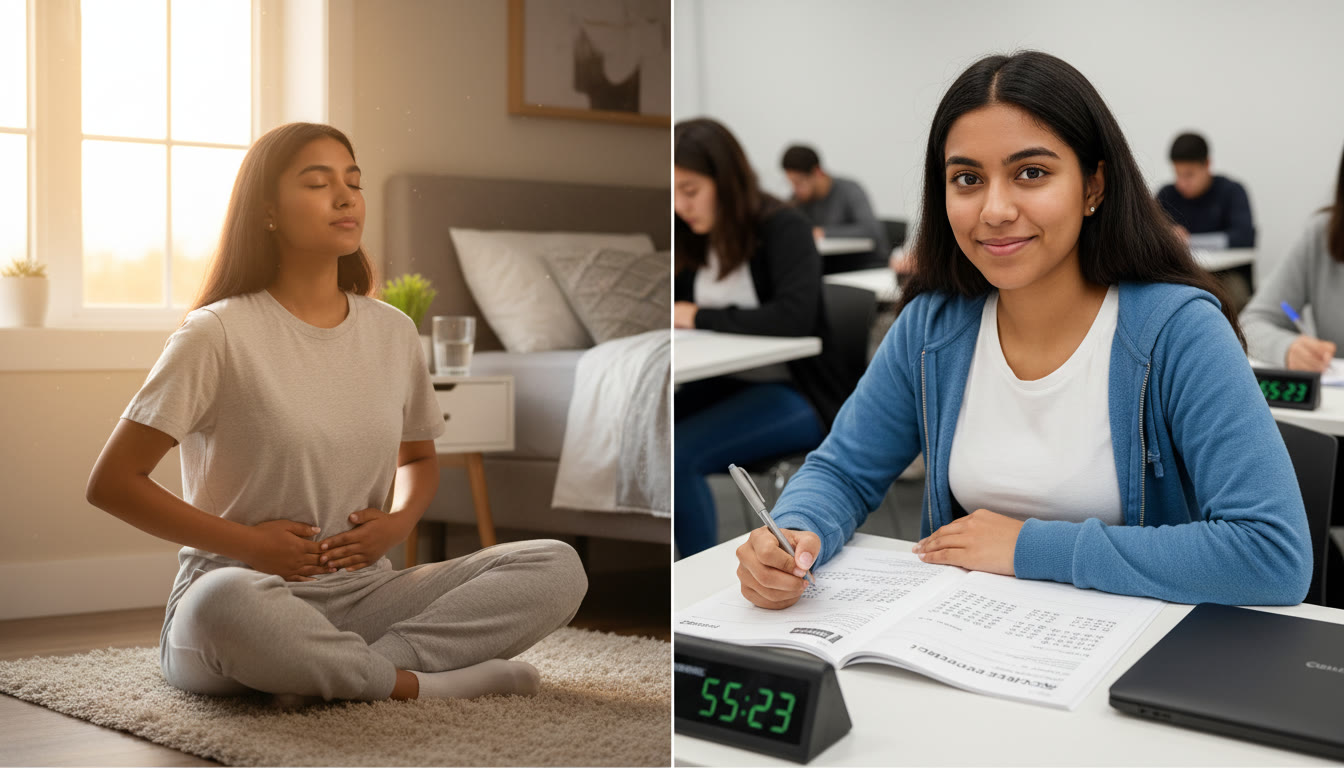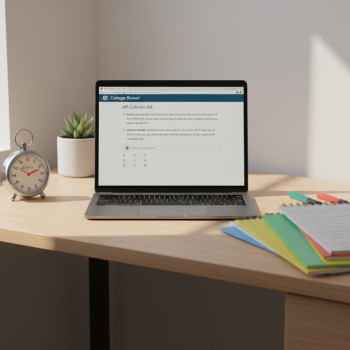Why breathing matters: the fastest tool you already have
Take a moment and notice your breath. Where is it? Shallow in your chest? Deep in your belly? The breath is the single-most immediate instrument you have to change how your body and mind feel in the present moment. For an AP student sitting down for an exam—when the clock ticks, the pages stare back, and your heart picks up the pace—breathing offers a direct, reliable way to dial anxiety down and attention up.

Why it works (short and useful)
When you breathe slowly and intentionally, your body shifts from a fight-or-flight state to a rest-and-digest state. That’s the parasympathetic nervous system doing its job: slowing the heart rate, reducing adrenaline, and clearing the fog that anxiety throws over working memory. The result is clearer thinking, fewer blank-outs, and the ability to retrieve facts you studied—especially handy on AP exams when recall and applied reasoning matter.
Simple breathing techniques you can use right at your desk
These techniques are short, non-dramatic, and suitable for use in a crowded classroom. Practice them in low-stress times (before school, during study breaks) so they become automatic during the test.
1. 4-4-4 Reset (the quickest)
Why: Fast and discreet. Use it when you need an immediate reset before reading a prompt or starting a section.
- Inhale quietly through your nose for 4 seconds.
- Hold gently for 4 seconds.
- Exhale slowly through your mouth for 4 seconds.
- Repeat 2–3 times.
Tip: Keep your posture slightly forward, feet on the floor—this grounds you and helps breath flow naturally.
2. Box Breathing (steady and focus-enhancing)
Why: Builds concentration and steadies the nervous system. Athletes, military personnel, and high performers use it—students benefit, too.
- Inhale for 4 counts.
- Hold for 4 counts.
- Exhale for 4 counts.
- Hold for 4 counts.
- Repeat for 3–5 rounds.
Tip: If 4 feels long, start with 3 counts and build to 4. The rhythm matters more than exact timing.
3. Diaphragmatic (Belly) Breathing — the deeper calm
Why: Activates the parasympathetic system strongly and reduces overall physiological arousal. Best for pre-exam warm-ups or during long breaks between sections.
- Sit upright. Place one hand on your chest and the other on your belly.
- Inhale through the nose so the belly expands and the chest stays relatively still (4–6 seconds).
- Exhale slowly through pursed lips for 6–8 seconds.
- Repeat for 5–10 cycles until you feel calmer.
Tip: Practice lying down at home to learn the mechanics; then transfer to seated practice for the exam room.
4. 7-11 Soothing Breath (for acute spikes of worry)
Why: Extends the exhale which signals the body to relax. Helpful when your mind floods with “what ifs” before a big free-response question.
- Inhale through the nose for a count of 4–7 (choose what’s comfortable).
- Exhale slowly through the mouth for a count of 8–11.
- Repeat until tension reduces—3–6 rounds usually does the trick.
How to integrate breathing into your AP routine (practical schedule)
Breathing shouldn’t be a secret trick you only pull under stress. Make it a scaffold of your study and test-day routine.
Before study sessions
- Spend 2 minutes on diaphragmatic breathing to start—this improves retention and focus.
- If you’re about to enter a practice exam, do two rounds of box breathing to reduce anxiety and increase attention span.
During study breaks
- Use short 4-4-4 resets between practice problems to clear frustration and reset working memory.
- Walk, stretch, then finish with one diaphragmatic breath sequence to return to study calmer and more efficient.
On exam day
- Arrive early and do a 3–5 minute diaphragmatic session in the lobby or restroom to center yourself.
- Before opening the test booklet, do a single round of box breathing to sharpen focus and steady the hand.
- If you feel a panic wave during the exam, stop for one 4-4-4 reset—no one will notice and you’ll save time by reducing blank-outs.
Real examples from students (how breathing changed the moment)
Real change doesn’t have to be dramatic. Here are two short, relatable vignettes based on common student experiences.
- Emma, an AP United States History student, used the 7-11 Soothing Breath after she blanked on an ID prompt. Two rounds later she recovered the timeline she needed and wrote the response without the initial fog. She credits the exhale-length with stopping the adrenaline spike.
- Marcus, preparing for AP Calculus AB, practiced box breathing during practice tests. On the real exam, when a tricky problem made his heart race, he paused for a box breath and returned calmer—able to reframe the problem and find a substitution that worked.
Short routines: pick one to memorize
Memorize a short breathing routine you can call on automatically. Practice it until it becomes as normal as rubbing your eyes.
| Routine Name | Length | Best Moment to Use | Steps |
|---|---|---|---|
| 4-4-4 Reset | 20–40 sec | Before starting a section | Inhale 4, hold 4, exhale 4 (repeat 2–3x) |
| Box Breathing | 1–2 min | When needing focus | Inhale 4, hold 4, exhale 4, hold 4 (repeat 3–5x) |
| Diaphragmatic Calm | 3–5 min | Pre-exam warm-up | Belly inhale 4–6, slow exhale 6–8 (repeat 10x) |
| 7-11 Soothing Breath | 1–2 min | During sudden panic | Inhale 4–7, exhale 8–11 (repeat 3–6x) |
When breathing alone isn’t enough: pair it with quick cognitive tricks
Breath calms the body; certain cognitive moves calm the mind. Combine them.
Label the feeling
Say to yourself (silently): “This is anxiety, not failure.” Labeling reduces the amygdala’s reactivity and helps you return to reasoned thought.
Use micro-planning
After two breaths, make a two-line action plan: “Scan the section, answer easiest first, mark hard problem for later.” The combination of breath + micro-plan turns panic into process.
Anchor with sensory detail
While breathing, notice one detail in the room—the texture of the paper, the sound of a pencil. Anchoring pulls you out of mental spirals and back to the present.
How to practice so you don’t fumble under stress
The trick is repetition in low-stakes times. Here’s a simple 7-day micro-practice plan to build a breathing habit that works on test day.
- Day 1–2: Two sessions of diaphragmatic breathing (3 minutes each), morning and evening.
- Day 3–4: Add 4-4-4 resets into one study session; use them between practice problems.
- Day 5: Do box breathing before a timed practice test.
- Day 6: Practice a 7-11 Soothing Breath after a challenging practice prompt to simulate recovery.
- Day 7: Run a mock exam and use your chosen routine at least three times during the test.
After the week, you’ll notice the breathing entering your reflexes—when panic comes, you’ll reach for breath before your mind spirals.
Addressing common concerns
“Will deep breathing make me dizzy?”
Only if you hyperventilate (fast, shallow breathing). That’s why these techniques emphasize slow, controlled cycles. Start with shorter counts and build them gradually. If you ever feel lightheaded, slow down and breathe normally until it passes.
“What if someone notices me?”
All techniques described are quiet and subtle. Most look like normal pauses. Teachers and proctors expect students to take small moments—use them confidently.
“I don’t have time between questions.”
Most routines are 20–90 seconds. Even a single 20-second 4-4-4 reset can prevent a negative cascade: fewer errors, faster recovery, and often a net time-saver because you avoid prolonged blank-outs.
Putting it all together: a test-day script
Here’s a short, practical script you can rehearse. It’s designed for AP exam conditions and minimizes fuss.
- Arrival (30–60 minutes before): 3 minutes of diaphragmatic breathing while reviewing a calm study checklist.
- Seat and materials check (10 minutes before): one box-breathing cycle to steady focus.
- Before opening the booklet: 4-4-4 Reset.
- After a difficult question: 7-11 Soothing Breath + one-sentence micro-plan.
- If panic returns: repeat one 4-4-4 Reset or box breathing as needed.
How tutoring and personalization amplify breathing practice
Breathing is powerful, but pairing it with tailored guidance accelerates results. For students working with a tutor, the tutor can help identify moments where anxiety typically spikes—like reading a dense stimulus in AP English or seeing a surprising graph in AP Statistics—and create short, specific breathing cues for those moments.
Sparkl’s personalized tutoring, for example, blends 1-on-1 guidance with tailored study plans and expert tutors who can coach you through practical breathing anchors during mock exams. Because the practice is individualized—matching your subject, timing, and typical stress points—you’ll learn not only the technique but the exact moment to use it for maximum effect. Sparkl’s AI-driven insights can also analyze practice-test patterns to suggest when breath cues are most helpful for you, turning calm practice into reliable exam-day performance.
Final thoughts: make calm a habit, not a one-off trick
AP exams are important, but how you approach them matters as much as how much content you know. Breathing techniques give you an elegant, portable way to protect your working memory and focus. The real power comes when you weave breath into study routines, mock exams, and your test-day rituals—so calm becomes a practiced response, not an afterthought.
Start small. Practice one routine for a week. Notice how your reaction to a hard question changes. With time and tiny, deliberate steps, you’ll find that the same breath you use to slow down also opens space to think faster, remember better, and show your real knowledge on the page.

Quick reference: one-page cheat sheet
Memorize this as your pocket map. Keep a printed copy during practice sessions so it becomes automatic.
| Problem | Breathing Fix | How Long |
|---|---|---|
| Heart racing before starting | 3 minutes Diaphragmatic | 3–5 min |
| Blank on a question | 4-4-4 Reset | 20–40 sec |
| Need sharper focus | Box Breathing | 1–2 min |
| Panic spike | 7-11 Soothing Breath + label feeling | 1–2 min |
Parting encouragement
If you’ve been relying purely on content cramming, adding a small breathing practice is one of the highest-return habits you can adopt. It costs nothing, can be done anywhere, and improves not just test performance but your day-to-day ability to manage pressure. Try it a little each day, and watch how often a few intentional breaths shift your exam from panic to problem-solving.
Good luck on your AP journey—breathe, trust your preparation, and let your knowledge do the talking.























No Comments
Leave a comment Cancel